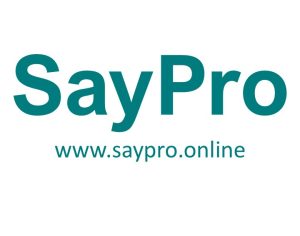Your cart is currently empty!
SayPro Financial and Resource Allocation Documents A breakdown of how resources were allocated for placement activities.
SayPro is a Global Solutions Provider working with Individuals, Governments, Corporate Businesses, Municipalities, International Institutions. SayPro works across various Industries, Sectors providing wide range of solutions.
Email: info@saypro.online Call/WhatsApp: Use Chat Button 👇

Here’s a detailed outline for the SayPro Financial and Resource Allocation Documents, designed to offer transparency and accountability in the distribution and use of resources throughout the placement activities. This section will also aid in evaluating whether the budget and resources were effectively utilized:
SayPro Financial and Resource Allocation Documents
Quarter: 4
Compiled by: SCDR by SayPro Advice Desk Officer
Programme: SayPro Development Royalty
Purpose
To provide a comprehensive breakdown of how resources—including funding, time, and support services—were allocated to placement activities during the quarter. This section ensures accountability, helps assess whether the allocated budget was used effectively, and supports future resource planning.
Resource Breakdown
- Funding Allocation
- Total Budget for Placements (Specify the allocated budget for placement activities for the quarter)
- Expenditure Overview:
- Direct Costs (e.g., stipends for participants, transport subsidies, material costs for training programs)
- Indirect Costs (e.g., administrative support, recruitment costs, coordination fees)
- Program-Specific Funding:
- Job Placements (Amount spent on job placement support, including employer stipends, job readiness workshops, etc.)
- Training Programs (Amount allocated for training materials, trainer fees, venue costs, etc.)
- Volunteer and Community Engagement (Resources dedicated to volunteer placements, community projects, and related activities)
- Contingency Fund (Any amount set aside for unexpected expenses)
- Time Allocation
- Total Time Spent on Placement Activities
- Team Coordination: Time spent by placement coordinators managing the process, including communication with employers, participants, and other stakeholders
- Participant Support: Time spent by staff on guiding, mentoring, and assisting participants throughout their placements
- Employer/Host Engagement: Time invested in liaising with employers, securing placements, and providing support
- Administrative and Operational Time:
- Time allocated to logistical support (e.g., travel arrangements, contract preparation)
- Time spent on feedback collection, evaluations, and reporting
- Total Time Spent on Placement Activities
- Support Services Allocation
- Participant Support:
- Mentorship and Guidance: Time and resources allocated to mentoring participants, including workshops and one-on-one sessions
- Career Counselling: Allocation for professional development support and career advice for participants
- Transport and Accessibility Support: Funding used for participant transport stipends or travel arrangements
- Employer/Host Organization Support:
- Employer Training: Resources allocated to training employers or community partners to effectively manage and mentor participants
- Onboarding Materials: Costs for onboarding resources for participants (e.g., orientation materials, equipment)
- Training and Development:
- Curriculum Development: Funding for creating and delivering job readiness and skills training courses
- Workshops/Seminars: Costs for hosting or sponsoring skill-building workshops or seminars
- Participant Support:
Sample Financial Breakdown for SayPro Placement Activities
| Resource Type | Budget Allocation | Actual Expenditure | Variance | Explanation |
|---|---|---|---|---|
| Direct Costs | $30,000 | $29,500 | -$500 | Minor savings from transportation subsidies |
| Indirect Costs | $12,000 | $11,800 | -$200 | Administrative cost savings due to remote work arrangements |
| Job Placement Support | $10,000 | $9,500 | -$500 | Slightly reduced due to fewer placements than expected |
| Training Programs | $15,000 | $14,750 | -$250 | Efficient use of resources in digital training platforms |
| Volunteer Engagement | $5,000 | $4,750 | -$250 | Savings in venue rental costs due to virtual workshops |
| Contingency Fund | $3,000 | $2,500 | -$500 | Unused portion allocated to unanticipated expenses |
Total Budget: $75,000
Total Expenditure: $72,300
Remaining Budget: $2,700
Evaluation of Resource Effectiveness
- Budget Efficiency
- The overall expenditure was within the allocated budget, with a small underrun of $2,700 that can be carried forward to the next quarter or reinvested into further placement initiatives.
- Direct costs for participant support, such as stipends and transport subsidies, were slightly lower than expected due to fewer participants requiring full support.
- Time Efficiency
- The placement team dedicated the appropriate amount of time to key activities, with coordination and support efforts being well-distributed across the quarter.
- Time spent on mentorship and employer engagement was slightly above average, reflecting the focus on enhancing participant success and employer satisfaction.
- Support Services Effectiveness
- The allocated resources for participant support services were well-utilized, particularly for transportation and onboarding materials.
- The employer training and community project support also received positive feedback, with both employers and community leaders praising the structured engagement.
Recommendations for Future Resource Allocation
- Increase Budget for Skills Development: A significant portion of the budget should be allocated to expanding training opportunities, particularly in emerging fields such as technology, healthcare, and green jobs.
- Enhance Transport Support: Given the feedback on transport challenges, more funds should be allocated to transportation stipends to ensure equitable access to placements.
- Allocate More Resources for Post-Placement Follow-up: A dedicated budget for post-placement engagement and support, including career coaching and job placement assistance, will increase long-term success for participants.
Conclusion
This document ensures that SayPro’s resources have been allocated effectively to maximize the impact of placement activities. Monitoring financial and resource allocations helps us continuously refine our approach and ensure that SayPro remains a cost-effective initiative that delivers valuable opportunities for all stakeholders.
Leave a Reply